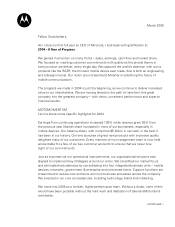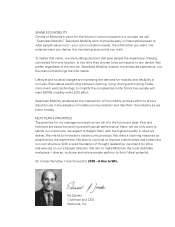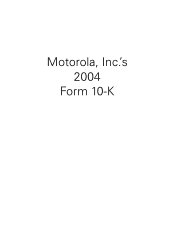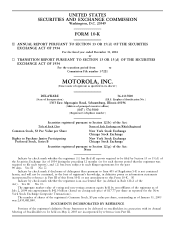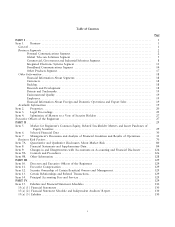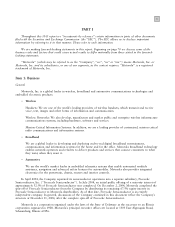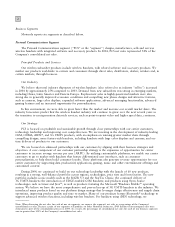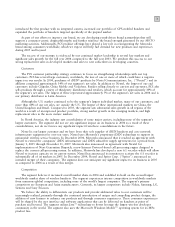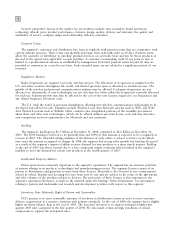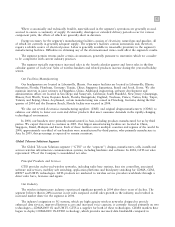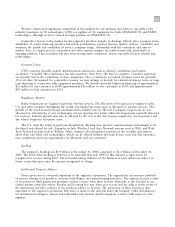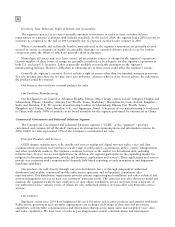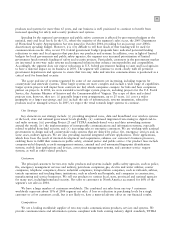Motorola 2004 Annual Report Download - page 12
Download and view the complete annual report
Please find page 12 of the 2004 Motorola annual report below. You can navigate through the pages in the report by either clicking on the pages listed below, or by using the keyword search tool below to find specific information within the annual report.
4
General competitive factors in the market for our products include: time-to-market; brand awareness;
technology oÅered; price; product performance, features, design, quality, delivery and warranty; the quality and
availability of service; company image and relationship with key customers.
Payment Terms
The segment's customers and distributors buy from us regularly with payment terms that are competitive with
current industry practices. These terms vary globally and range from cash-with-order to 60 days. Payment terms
allow the customer or distributor to purchase products from us on a periodic basis and pay for those products at
the end of the agreed term applicable to each purchase. A customer's outstanding credit at any point in time is
limited to a predetermined amount as established by management. Extended payment terms beyond 60 days are
provided to customers on a case-by-case basis. Such extended terms are not related to a signiÑcant portion of our
revenues.
Regulatory Matters
Radio frequencies are required to provide wireless services. The allocation of frequencies is regulated in the
U.S. and other countries throughout the world, and limited spectrum space is allocated to wireless services. The
growth of the wireless and personal communications industry may be aÅected if adequate frequencies are not
allocated or, alternatively, if new technologies are not developed to better utilize the frequencies currently allocated
for such use. Industry growth may also be aÅected by the cost of the new licenses required to use frequencies and
any related frequency relocation costs.
The U.S. leads the world in spectrum deregulation, allowing new wireless communications technologies to be
developed and oÅered for sale. Examples include Wireless Local Area Network systems such as WiFi, and Wide
Area Network systems such as WiMax. Other countries also deregulated portions of the available spectrum to
allow these and other new technologies, which can be oÅered without spectrum license costs and may introduce
new competition and new opportunities for Motorola and our customers.
Backlog
The segment's backlog was $1.5 billion at December 31, 2004, compared to $2.2 billion at December 31,
2003. The 2004 backlog is believed to be generally Ñrm and 100% of that amount is expected to be recognized as
revenue in 2005. The forward-looking estimates of the Ñrmness of such orders is subject to future events which
may cause the amount recognized to change. In 2004, the segment had strong order growth but backlog decreased
as a result of the segment's improved ability to meet demand for new products in a more timely manner. Backlog
at the end of 2003 was above normal due to a key component supply constraint which resulted in the segment's
inability to meet the demand for certain new products in the fourth quarter of 2003.
Intellectual Property Matters
Patent protection is extremely important to the segment's operations. The segment has an extensive portfolio
of patents relating to its products, technologies and manufacturing processes. The segment licenses certain of its
patents to third parties and generates revenue from these licenses. Motorola is also licensed to use certain patents
owned by others. Royalty and licensing fees vary from year to year and are subject to the terms of the agreements
and sales volumes of the products subject to licenses. The protection of these licenses is also important to the
segment's operations. Reference is made to the material under the heading ""Other Information'' for information
relating to patents and trademarks and research and development activities with respect to this segment.
Inventory, Raw Materials, Right of Return and Seasonality
PCS's practice is to carry reasonable amounts of inventory in distribution centers in order to meet customer
delivery requirements in a manner consistent with industry standards. At the end of 2004, the segment had a slightly
higher inventory balance than at the end of 2003. The increased inventory is to support anticipated higher Ñrst
quarter 2005 sales compared to the Ñrst quarter of 2004. We also made certain strategic purchases of critical
components to support the anticipated sales.



